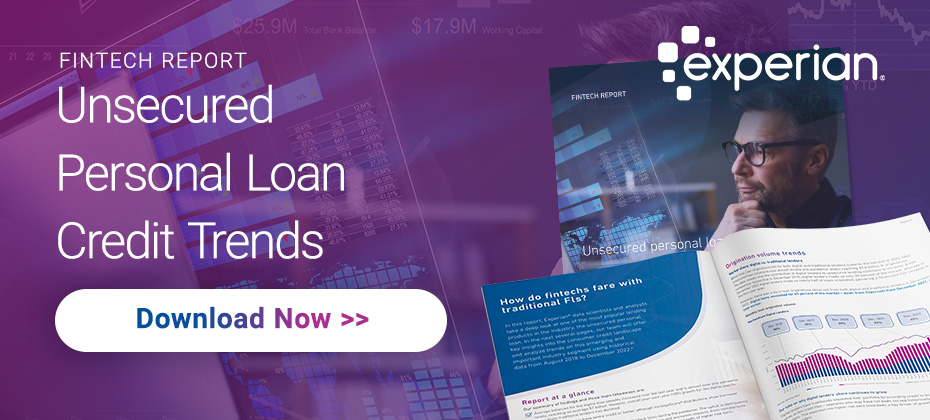Latest Posts

Evolving technologies and rising consumer expectations for fast, frictionless experiences highlight an opportunity for credit unions to advance their decisioning and stand out in a crowded market. How a credit union is optimizing their decision-making process With over $7.2 billion in assets and 330,000 members, Michigan State University Federal Credit Union (MSUFCU) aims to provide superior service to their members and employees. Initially reliant on manual reviews, the credit union needed a well-designed decisioning strategy that could help them grow their loan portfolio, increase employee efficiency, and reduce credit risk. The credit union implemented Experian’s decisioning platform, PowerCurve® Originations, to make faster, more accurate credit decisions on their secured and unsecured personal loans, leading to increased approvals and an exceptional member experience. “Day one of using PowerCurve produced a 49% automation rate! We have received amazing feedback from our teams about what a great product was chosen,” said Blake Johnson, Vice President of Lending, Michigan State University Federal Credit Union. After implementing PowerCurve Originations, MSUFCU saw an average monthly automation rate of more than 55% and decreased their application processing time to less than 24 hours. Read the full case study for more insight on how Experian can help power your decisioning to grow your business and member relationships. Download case study

The ability to verify customer identities is essential for financial institutions for numerous reasons: regulatory requirements, for the protection of their consumers and their business, mitigating risk and more. Being able to detect high-risk customers and large transactions is a critical component of Know Your Customer (KYC) strategies. In addition to being good business practices, this type of risk mitigation is also outlined in industry regulations. In an increasingly complex regulatory environment, companies may be faced with meeting multiple KYC and Anti-Money Laundering (AML) requirements. Actions taken to validate customers such as enhanced due diligence in KYC compliance have impacts spanning far beyond just regulatory compliance. As with any business, bottom line and budget are primary drivers for many financial institutions. Enhanced due diligence (EDD) can positively impact a business's bottom line by contributing to the reduction of fraud rates. And with increased security to discover potential fraudsters, organizations can protect both customers and reputational value. Enhanced due diligence explained: Why KYC, CIP and AML are critical in financial services EDD takes Customer Due Diligence (CDD) to the next level. Financial institutions conduct CDD to protect their organizations from financial crime. CDD is also a critical component of KYC steps to comply with AML laws. AML legislation requires financial institutions to validate their customers to ensure they aren’t part of explicitly illegal financial activity or funding terrorism. EDD is, as it sounds, a more involved form of due diligence, which encompasses additional procedures. EDD involves determining a customer’s risk, often requiring additional information and evidence to determine their viability. While CDD is performed on all customers, EDD is reserved for high-risk potential customers. Because EDD is often more costly and involved in terms of time and resources, a risk-based approach is recommended to flag only the instances when this additional level of validity is required. KYC references the mandatory process of identifying and verifying a client’s identity at account opening and over the course of their relationship with a company to ensure they are the person they say they are. KYC consists of three parts: Customer identification program (CIP), CDD and EDD. CIP requires, at minimum, that financial institutions provide four pieces of identifying information including name, date of birth, address and identification number. CDD consists of classifying the identifying information that was collected. After identifying who the client is (via CIP), CDD assesses the information to determine risk. Enhanced due diligence in KYC In order to establish a competent EDD program, you must improve your CIP and KYC programs. Objective, automated and efficient identity verification capabilities help you acquire profitable, legitimate customers and monitor them effectively over time to meet regulatory compliance expectations. How can EDD benefit your business? Failing to comply with EDD regulations can result in countless risks for financial institutions like fines and reputational losses. While many customers pose little to no risk, high-risk individuals must be flagged quickly and efficiently. The primary benefit of EDD is to protect both financial institutions and their customers from financial crimes such as money laundering and terrorist financing, but there are other risks as well. By mitigating potential risks associated with higher-risk customers, EDD can prevent financial institutions from incurring regulatory fines, legal action, and damage to their reputation. In turn, this ensures that customers have more trust in their financial service providers. Financial institutions can then gain a competitive advantage by offering more secure financial products and services that investors, businesses and customer demand. Access EDD from Experian Experian leverages our advanced analytics, reliable data sources, and team of experts to conduct objective, full and comprehensive due diligence with confidence and certainty. Our solutions, including flexible monitoring and segmentation tools, allow you to resolve discrepancies and fraud risk in a single step, all while keeping pace with emerging fraud threats with effective customer identification software. Improving your Customer Identification Program (CIP) and KYC programs In conclusion, Enhanced Due Diligence in KYC, CIP, and AML are critical components of the financial services regulatory compliance framework. EDD goes beyond the standard KYC, CIP, and AML checks to mitigate risks associated with higher-risk customers. Implementing EDD can help financial institutions comply with regulatory requirements, protect against potential risks, and prevent financial crimes. Ultimately, this benefits not only the institutions but also their customers and the broader economy. It’s vital that financial institutions understand and appreciate the importance of EDD and take appropriate measures to implement it effectively. Experian offers objective, automated and efficient identity verification solutions to help you acquire profitable, legitimate customers and monitor them over time to meet regulatory compliance expectations. Discover the power of CIP and KYC solutions. Learn more

More than half of U.S. businesses say they discuss fraud management often, making fraud detection in banking top-of-mind. Banking fraud prevention can seem daunting, but with the proper tools, banks, credit unions, fintechs, and other financial institutions can frustrate and root out fraudsters while maintaining a positive experience for good customers. What is banking fraud? Banking fraud is a type of financial crime that uses illegal means to obtain money, assets, or other property owned or held by a bank, other financial institution, or customers of the bank. This type of fraud can be difficult to detect when misclassified as credit risk or written off as a loss rather than investigated and prevented in the future. Fraud that impacts financial institutions consists of small-scale one-off events or larger efforts perpetrated by fraud rings. Not long ago, many of the techniques utilized by fraudsters required in-person or phone-based activities. Now, many of these activities are online, making it easier for fraudsters to disguise their intent and perpetrate multiple attacks at once or in sequence. Banking fraud can include: Identity theft: When a bad actor steals a consumer’s personal information and uses it to take money, open credit accounts, make purchases, and more. Check fraud: This type of fraud occurs when a fraudster writes a bad check, forges information, or steals and alters someone else’s check. Credit card fraud: A form of identity theft where a bad actor makes purchases or gets a cash advance in the name of an unsuspecting consumer. The fraudster may takeover an existing account by gaining access to account numbers online, steal a physical card, or open a new account in someone else’s name. Phishing: These malicious efforts allow scammers to steal personal and account information through use of email, or in the case of smishing, through text messages. The fraudster often sends a link to the consumer that looks legitimate but is designed to steal login information, personally identifiable information, and more. Direct deposit account fraud: Also known as DDA fraud, criminals monetize stolen information to open new accounts and divert funds from payroll, assistance programs, and more. Unfortunately, this type of fraud doesn’t just lead to lost funds – it also exposes consumer data, impacts banks’ reputations, and has larger implications for the financial system. Today, top concerns for banks include generative AI (GenAI) fraud, peer-to-peer (P2P) payment scams, identity theft and transaction fraud. Without the proper detection and prevention techniques, it’s difficult for banks to keep fraudsters perpetrating these schemes out. What is banking fraud prevention? Detecting and preventing banking fraud consists of a set of techniques and tasks that help protect customers, assets and systems from those with malicious intent. Risk management solutions for banks identify fraudulent access attempts, suspicious transfer requests, signs of false identities, and more. The financial industry is constantly evolving, and so are fraudsters. As a result, it’s important for organizations to stay ahead of the curve by investing in new fraud prevention technologies. Depending on the size and sophistication of your institution, the tools and techniques that comprise your banking fraud prevention solutions may look different. However, every strategy should include multiple layers of friction designed to trip up fraudsters enough to abandon their efforts, and include flags for suspicious activity and other indicators that a user or transaction requires further scrutiny. Some of the emerging trends in banking fraud prevention include: Use of artificial intelligence (AI) and machine learning (ML). While these technologies aren’t new, they are finding footing across industries as they can be used to identify patterns consistent with fraudulent activity – some of which are difficult or time-consuming to detect with traditional methods. Behavioral analytics and biometrics. By noting standard customer behaviors — e.g., which devices they use and when — and how they use those devices — looking for markers of human behavior vs. bot or fraud ring activity — organizations can flag riskier users for additional authentication and verification. Leveraging additional data sources. By looking beyond standard credit reports when opening credit accounts, organizations can better detect signs of identity theft, synthetic identities, and even potential first-party fraud. With real-time fraud detection tools in place, financial institutions can more easily identify good consumers and allow them to complete their requests while applying the right amount and type of friction to detect and prevent fraud. How to prevent and detect banking fraud In order to be successful in the fight against fraud and keep yourself and your customers safe, financial institutions of all sizes and types must: Balance risk mitigation with the customer experience Ensure seamless interactions across platforms for known consumers who present little to no risk Leverage proper identity resolution and verification tools Recognize good consumers and apply the proper fraud mitigation techniques to riskier scenarios With Experian’s interconnected approach to fraud detection in banking, incorporating data, analytics, fraud risk scores, device intelligence, and more, you can track and assess various activities and determine where additional authentication, friction, or human intervention is required. Learn more

Credit risk refers to the likelihood that a borrower will fail to repay a debt as agreed. Credit risk management is the art and science of utilizing risk mitigation tools to minimize losses while maximizing profits from lending activities. Lenders can establish credit underwriting criteria for each of their products and utilize risk-based pricing to adjust the terms of a loan or line of credit based on the risk associated with the product and borrower. Credit portfolio management extends beyond originations and individual decisions to encompass portfolios as a whole. Why is credit risk management important? Continuously managing credit risk matters because there's always a balancing act. Tightening a credit box – using more restrictive underwriting criteria – might reduce credit losses. However, it can also decrease approval rates, excluding borrowers who would have repaid as agreed. Expanding a credit box might increase approval rates, but it is only beneficial if the profit from good new loans exceeds credit losses. Fraud is also on the rise and becoming increasingly complex, making fraud management a crucial part of understanding risk. For instance, with synthetic identity fraud, fraudsters might “age an account" or make on-time payments before “busting out” or maxing out a credit card, and then abandoning the account. If you examine payment activity alone, it may be challenging to classify the loss as either a fraud loss or a credit loss. Additionally, external economic forces and consumer behavior are constantly in flux. Financial institutions need effective consumer risk management and to adjust their strategies to minimize losses. And they must dynamically adjust their underwriting criteria to account for these changes. You could be pushed off balance if you don't react in time. What does managing credit risk entail? Lenders have used the five C’s of credit to measure credit risk and make lending decisions for decades: Character: The likelihood a borrower will repay the loan as agreed, often measured by analyzing their credit report and a credit risk score. Capacity: The borrower's ability to pay, which lenders might measure by reviewing their outstanding debt, income, and debt-to-income ratio. Capital: The borrower's commitment to the purchase, such as their down payment when buying a vehicle or home. Collateral: The value of the collateral, such as a vehicle or home, for an auto loan or mortgage. Conditions: The external conditions that can impact a borrower's ability to afford payments, such as broader economic trends. Credit risk management considers these within the context of a lender’s goals and its specific lending products. For example, capital and collateral aren't relevant for unsecured personal loans, which makes character and capacity the primary drivers of a decision. Credit risk management best practices at origination Advances in analytics, computing power and real-time access to additional data sources are helping lenders better measure some of the C’s. For example, credit risk scores can more precisely assess character for a lender's target market than generic risk scores. Open banking data enables lenders to more accurately assess a borrower's capacity by directly analyzing their cash flows. With these advances in mind, leading lenders: View underwriting as a dynamic process: Lenders have always had to respond to changing forces, and the pandemic highlighted the need to be nimble. Consider how you can utilize analytical insights to quickly adjust your strategies. Test the latest credit risk modeling techniques: Artificial intelligence (AI) and machine learning (ML) techniques can improve credit risk model performance and drive automated credit risk decisioning. Use multiple data sources: Alternative credit data and consumer-permissioned data offer increased and real-time visibility into borrowers' creditworthiness to help lenders more accurately assess credit risk. These additional data sources can score those who are unscoreable by conventional models and help fuel ML credit risk models. Experian helps lenders measure and manage credit risk Experian is a leading provider of traditional credit data, alternative credit data and credit risk analytics. For those who want to quickly benefit from the latest technological advancements, our Lift Premium credit risk model utilizes both traditional and alternative data to score up to 96 percent of U.S. consumers — compared to the 81 percent that conventional models can score.¹ Experian’s Ascend Platform and Ascend Intelligence Services™ can help lenders develop, deploy and monitor custom credit risk models to optimize their decisions. With end-to-end platforms, our account and portfolio management services can help you limit risk, detect fraud, automate underwriting and identify opportunities to grow your business. Learn more about credit risk management ¹Experian (2023). Lift Premium™ and Lift Plus™

Experian’s eighth annual identity and fraud report found that consumers continue to express concerns with online security, and while businesses are concerned with fraud, only half fully understand its impact – a problem we previously explored in last year’s global fraud report. In our latest report, we explore today’s evolving fraud landscape and influence on identity, the consumer experience, and business strategies. We surveyed more than 2,000 U.S. consumers and 200 U.S. businesses about their concerns, priorities, and investments for our 2023 Identity and Fraud Report. This year’s report dives into: Consumer concerns around identity theft, credit card fraud, online privacy, and scams such as phishing.Business allocation to fraud management solutions across industries.Consumer expectations for both security and their experience.The benefits of a layered solution that leverages identity resolution, identity management, multifactor authentication solutions, and more. To identify and treat each fraud type appropriately, you need a layered approach that keeps up with ever-changing fraud and applies the right friction at the right time using identity verification solutions, real-time fraud risk alerts, and enterprise orchestration. This method can reduce fraud risks and help provide a more streamlined, unified experience for your consumers. To learn more about our findings and how to implement an effective solution, download Experian’s 2023 Identity and Fraud Report. Download the report

In a changing economy, banks of all sizes are more budget conscious, leading many to pull back on their marketing spend for new customer acquisition. But by making strategic marketing moves now, banks can uncover new opportunities and drive profitable, long-term growth. So, how can you find, engage, and win over high-value customers? Know who’s in the market for credit To build an effective bank customer acquisition strategy, you’ll want to be proactive with your campaign planning. Let’s say you’ve already defined your customer profile and have insights into their interests, lifestyles, and demographics. With predictive metrics and advanced tools like trended data and propensity-to-open models, you can further refine your segmentation strategies by identifying individuals who are likely to be in the market for your product. This way, you can reach consumers at the right time and personalize offers to achieve higher open rates. Embrace the digital era With today’s consumers increasing their banking activities online, leveraging digital channels in your bank customer acquisition strategy is imperative. In addition to connecting with consumers through direct mail, consider reaching out to them through email, social media, or your mobile banking applications. This will not only help increase the visibility of the offer, but also allow consumers to receive and respond faster. Another way to enhance your banking strategies for growth while meeting consumer expectations for digital is by making it easier and more convenient for consumers to onboard. With an automated and data-driven credit decisioning solution, you can streamline steps that are traditionally manual and time-consuming, such as data collection and identity verification. By providing seamless customer acquisition in banking, you can accelerate your decision-making and increase the likelihood of conversion. Make the most of your marketing spend While customer acquisition in banking should remain a high priority, we understand that driving growth on a tight marketing budget can be challenging. That’s why we created a tip sheet outlining ways for banks and other lenders to enhance their customer acquisition processes while effectively managing costs. Some of the tips include: Going beyond conventional scoring methods. By leveraging an advanced customer acquisition solution, you can gain a holistic view of your prospective customers to enhance predictive performance and identify hidden growth opportunities. Focusing on high-potential customers. Pinpointing consumers who are actively seeking credit enables you to focus your offers and resources on those who are likely to respond, resulting in a greater return on marketing investment. Amplifying your credit offers. Re-presenting preapproved credit offers through the digital channels that consumers most frequent enables you to expand your campaign reach, increase response rates, and reduce direct mailing costs. View the tip sheet to learn how you can make the most of your marketing budget to acquire new customers and drive long-term growth. Access tip sheet

‘Big data’ might not be the buzzword du jour, but it's here to stay. Whether trying to improve your customer experience, portfolio performance, automation, or new AI capabilities, access to quality data from varying data sources can create growth opportunities. 85 percent of organizations believe that poor-quality customer contact data negatively affects their operations and efficiencies, which leads to wasted resources and damages their brand. And 77 percent said that inaccurate data hurt their response to market changes during the pandemic.1 If you want to use data to drive your business forward, consider where the data comes from and how you can glean useful insights. What is a data source? A data source is a location where you can access information. It's a broad description because data sources can come in different formats — the definition depends on how the data is being used rather than a specific storage type. For example, you can get data from a spreadsheet, sensors on an internet of things device or scrape it from websites. You might store the data you gather using different types of databases. And in turn, those databases can be data sources for other programs or organizations. Types of data sources Many organizations have chief data officers, along with data engineers, scientists and analysts who gather, clean, organize and manage data. This important work relies on understanding the technical aspects of varying data sources and connections. And it can turn a disorganized pool of data into structured databases that business leaders can easily access and analyze. From a non-technical point of view, it’s important to consider where the data comes from and the pros and cons of these data sources. For instance, marketers might define data sources as: First-party data: The data collected about customers and prospects, such as account details, transaction history and interactions with your website or app. The data can be especially valuable and insightful when you can connect the dots between previously siloed data sources within your organization.Zero-party data: Some organizations have a separate classification for information that customers voluntarily share, such as their communication preferences and survey results. It can be helpful to view this data separately because it reflects customers' desires and interests, which can be used to further customize your messaging and recommendations.Second-party data: Another organization's first-party data can be your second-party data if you purchase it or have a partnership that involves data sharing or data collaboration. Second-party data can be helpful because you know exactly where the information comes from and it can complement information you already have about customers or prospects.Third-party data: Third-party data comes from aggregators that collect and organize information from multiple sources. It can further enrich your customer view to improve marketing, underwriting, customer service and collection efforts. READ: The Realizing a Single Customer View white paper explores how organizations can use high-quality data to better understand their customers. How can a data-driven approach benefit your business? Organizations use data science to make sense of the increasingly large flow of information from varying data sources. A clear view can be important for driving growth and responding to changing consumer preferences and economic uncertainty. A 2022 survey of U.S. organizations found high-quality data can help:2 Grow your business: 91 percent said investing in data quality helped business growth.Improve customer experience: 90 percent said better data quality led to better customer experiences.Increase agility: 89 percent said best practices for data quality improved business agility. You can see these benefits play out in different areas. For example, you can more precisely segment customers based on reliable geographic, demographic, behavioral and psychographic data. Or combine data sources to get a more accurate view of consumer risk and increase your AI-powered credit risk decisioning capabilities. But building and scaling data systems while maintaining good quality isn't easy. Many organizations have to manage multiple internal and external data sources, and these can feed into databases that don't always communicate with one another. Most organizations (85 percent) are looking toward automation to improve efficiency and make up for skill shortages. Most are also investing in technology to help them monitor, report and visualize data — making it easier to understand and use.3 WATCH: See how you can go from data to information to insight and foresight in the Using Business Intelligence to Unlock Better Lending Decisions webinar. Access high-quality data from Experian Digital acceleration has made accessing quality data more important than ever. This includes learning how to collect and manage your zero- and first-party data. Experian's data quality management solutions can help you aggregate, cleanse and monitor your data. And the business intelligence tools and platform democratize access, allowing non-technical business leaders to find meaningful insights. You can also enhance your data sets with second- and third-party data. Our industry-leading data sources have information on over 245 million consumers and 32 million businesses, including proprietary data assets. These include traditional credit bureau data, alternative credit data, automotive data, commercial credit data, buy now pay later data, fraud data and residential property data. And you can use our API developer portal to access additional third-party data sources within the same interface. Learn more about Experian's data sources. 1. Experian (2022). 2022 Global Data Management Research Report2. Experian (2022). The Data Quality Imperative3. Ibid.

After being in place for more than three years, the student loan payment pause is scheduled to end 60 days after June 30, with payments resuming soon after. As borrowers brace for this return, there are many things that loan servicers and lenders should take note of, including: Potential risk factors demonstrated by borrowers. About one in five student loan borrowers show risk factors that suggest they could struggle when scheduled payments resume.1 These include pre-pandemic delinquencies on student loans and new non-medical collections during the pandemic. The impact of pre-pandemic delinquencies. A delinquent status dating prior to the pandemic is a statistically significant indicator of subsequent risk. An increase in non-student loan delinquencies. As of March 2023, around 2.5 million student loan borrowers had a delinquency on a non-student loan, an increase of approximately 200,000 borrowers since September 2022.2 Transfers to new servicers. More than four in ten borrowers will return to repayment with a new student loan servicer.3 Feelings of anxiety for younger borrowers. Roughly 70% of Gen Z and millennials believe the current economic environment is hurting their ability to be financially independent adults. However, 77% are striving to be more financially literate.4 How loan servicers and lenders can prepare and navigate Considering these factors, lenders and servicers know that borrowers may face new challenges and fears once student loan payments resume. Here are a few implications and what servicers and lenders can do in response: Non-student loan delinquencies can potentially soar further. Increased delinquencies on non-student loans and larger monthly payments on all credit products can make the transition to repayment extremely challenging for borrowers. Combined with high balances and interest rates, this can lead to a sharp increase in delinquencies and heightened probability of default. By leveraging alternative data and attributes, you can gain deeper insights into your customers' financial behaviors before and during the payment holidays. This way, you can mitigate risk and improve your lending and servicing decisions. Note: While many student loan borrowers have halted their payments during forbearance, some have continued to pay anyway, demonstrating strong financial ability and willingness to pay in the future. Trended data and advanced modeling provide a clearer, up-to-date view of these payment behaviors, enabling you to identify low-risk, high-value customers. Streamlining your processes can benefit you and your customers. With some student loan borrowers switching to different servicers, creating new accounts, enrolling in autopay, and confirming payment information can be a huge hassle. For servicers that will have new loans transferred to them, the number of queries and requests from borrowers can be overwhelming, especially if resources are limited. To make transitions as smooth as possible, consider streamlining your administrative tasks and processes with automation. This way, you can provide fast and frictionless service for borrowers while focusing more of your resources on those who need one-on-one assistance. Providing credit education can help borrowers take control of their financial lives. Already troubled by higher costs and monthly payments on other credit products, student loan payments are yet another financial obligation for borrowers to worry about. Some borrowers have even stated that student loan debt has delayed or prevented them from achieving major life milestones, such as getting married, buying a home, or having children.5 By arming borrowers with credit education, tools, and resources, they can better navigate the return of student loan payments, make more informed financial decisions, and potentially turn into lifelong customers. For more information on effective portfolio management, click here. 1Consumer Financial Protection Bureau. (June 2023). Office of Research blog: Update on student loan borrowers as payment suspension set to expire. 2Ibid. 3Ibid. 4Experian. (May 2023). Take a Look: Millennial and Gen Z Personal Finance Trends 5AP News. (June 2023). The pause on student loan payment is ending. Can borrowers find room in their budgets?

Credit portfolio management has often involved navigating uncertainty, but some periods are more extreme than others. With the right data and analytics you can gain deeper insight into financial behaviors and risk to make better decisions and drive profitable growth. Along with access to an increasing amount of data, advanced analytics can help lenders more accurately: Forecast losses under different economic scenarios to estimate liquidity requirements. Identify fraud by detecting behaviors that could indicate identity theft, account takeover fraud, first-party or synthetic identity fraud. Incorporate real-time and alternative data,1 such as cash flow transaction data and specialty bureau data, in decisioning and scoring to accurately assess creditworthiness and expand your lending pool without taking on undue risk. Precisely segment consumers using internal and external data to increase automation during underwriting and identify cross-sell opportunities. Improve collections using AI-driven strategies and automated debt collection software to enhance operations and increase recovery rates. It’s imperative to take a proactive approach to portfolio monitoring. Monthly portfolio reviews with bureau scores, credit attributes and specialized scores — and using the results to manage credit lines and loan terms — are critical during volatile times. View our interactive e-book for the latest economic and consumer trends and learn how to set your portfolio up to succeed in any economic cycle. Download e-book 1"Alternative credit data" refers to the use of alternative data and its appropriate use in consumer credit lending decisions, as regulated by the Fair Credit Reporting Act. Hence, the term “expanded FCRA data" may also apply in this instance, and both can be used interchangeably.

Millions of people access the internet every day using desktop computers, laptops, and mobile devices. Though an increased number of online users have been accessing the web while working from home due to the pandemic, many are still going online in public places and using public wi-fi and/or unsecured networks, such as coffee shops, airports, and internet cafes. While it may be convenient to access the internet from anywhere at any time, there are risks involved with doing so. Connecting to the internet on an unsecured network without the proper protection can render your device vulnerable to data collection, tracking, and targeting from hackers. The best way to protect yourself from these kinds of attacks is to use a Virtual Private Network, or VPN. What is a Virtual Private Network? A Virtual Private Network (VPN) creates an encrypted, private connection to the internet that allows you to securely browse the web while protecting your information from being tracked or targeted. Globally, there are approximately 1.5 billion VPN users as of 2023, making up about a third of all internet users worldwide. 43% of these people use a VPN for security reasons.[1] How does a VPN work? A VPN routes your internet traffic through a different server, rather than the server your internet service provider usually uses. The data you send and receive is then encrypted, so even if it were to fall into the wrong hands, it would be unreadable. Your data will appear to be sent from the VPN itself, instead of from your device. This provides an additional layer of privacy to your browsing experience, especially if you’re using a public or unsecured network to access the internet. How can you use a VPN? With Experian’s Secure VPN, what you search, see, and share on your mobile or desktop devices stays hidden from hackers, preventing data collection, tracking, and targeting. You can confidently connect to a stronger, more reliable, private Wi-Fi connection that secures your devices’ online or offline activity. What are the benefits of Experian’s Secure VPN? You can use Experian’s Secure VPN on an unlimited number of desktop and mobile devices, so your whole family can be protected. Secure VPN’s high-speed connection ensures that you won’t need to worry about slow loading times or dropped connections, and its unrivaled security allows you to take advantage of best-in-class privacy. Browsing the internet on an unsecured network is risky and can leave you open to data theft and identity fraud. By using a VPN, you’ll enjoy a safer, more secure internet experience. Visit our website to learn more about Experian’s Digital Privacy and Control solutions. [1]DataProt.net. VPN Statistics for 2023 – Keeping Your Browsing Habits Private.

Banking uncertainty creates opportunity for fraud The recent regional bank collapses left anxious consumers scrambling to withdraw their funds or open new accounts at other institutions. Unfortunately, this situation has also created an opportunity for fraudsters to take advantage of the chaos. Criminals are exploiting the situation and posing as legitimate customers looking to flee their current bank to open new accounts elsewhere. Financial institutions looking to bring on these consumers as new clients must remain vigilant against fraudulent activity. Fraudsters also prey on vulnerable individuals who may be financially stressed and uncertain about the future. This creates a breeding ground for scams as fear and uncertainty cloud judgment and make people more susceptible to manipulation. Beware of fraudulent tactics Now, it is more important than ever for financial institutions to be vigilant in their due diligence processes. As they navigate this period of financial turbulence, they must take extra precautions to ensure that new customers are who they say they are by verifying customer identities, conducting thorough background checks where necessary, and monitoring transactions for any signs of suspicious activity. Consumers should also maintain vigilance — fraudulent schemes come in many forms, from phishing scams to fake investment opportunities promising unrealistic returns. To protect yourself against these risks, it is important to remain vigilant and take precautions such as verifying the legitimacy of any offers or investments before investing, monitoring your bank and credit card statements regularly for suspicious activity, and being skeptical of unsolicited phone calls, emails, or text messages. Security researcher Johannes Ulrich reported that threat actors are jumping at the opportunity, registering suspicious domains related to Silicon Valley Bank (SVB) that are likely to be used in attacks. Ulrich warned that the scammers might try to contact former clients of SVB to offer them a support package, legal services, loans, or other fake services relating to the bank's collapse. Meanwhile, on the day of the SVB closure, synthetic identity fraud began to climb from an attack rate of .57 to a first peak of 1.24% on the Sunday following the closure, or an increase of 80%. After the first spike reduced on March 14, we only saw a return of an even higher spike on March 21 to 1.35%, with bumps continuing since then. As the economy slows and fraud rises, don’t let your guard down The recent surge in third-party attack rates on small business and investment platforms is a cause for concern. There was a staggering nearly 500% increase in these attacks between March 7th and 11th, which coincided with the release of negative news about SVB. Bad actors had evidently been preparing for this moment and were quick to exploit vulnerabilities they had identified across our financial system. They used sophisticated bots to create multiple accounts within minutes of the news dropping and stole identities to perpetrate fraudulent activities. This underscores the need for increased vigilance and proactive measures to protect against cyber threats impacting financial institutions. Adopting stronger security measures like multi-factor authentication, real-time monitoring, and collaboration with law enforcement agencies for timely identification of attackers is of paramount importance to prevent similar fraud events in the future. From frictionless to friction-right As businesses seek to stabilize their operations in the face of market turbulence, they must also remain vigilant against the threat of fraud. Illicit activities can permeate a company's ecosystem and disrupt its operations, potentially leading to financial losses and reputational damage. Safeguarding against fraud is not a simple task. Striking a balance between ensuring a smooth customer experience and implementing effective fraud prevention measures can be a challenging endeavor. For financial institutions in particular, being too stringent in fraud prevention efforts may drive customers away, while being too lenient can expose them to additional fraud risks. This is where a waterfall approach, such as that offered by Experian CrossCore®, can prove invaluable. By leveraging an array of fraud detection tools and technologies, businesses can tailor their fraud prevention strategies to suit the specific needs and journeys of different customer segments. This layered, customized approach can help protect businesses from fraud while ensuring a seamless customer experience. Learn more

With an ever-present need for efficiency, security, and seamless citizen services, many agencies are looking at the benefits of a data-driven government. Last year, the federal government kicked off a unified effort to enable data-driven decision making. The goal at that level – and across all agencies – is to serve citizens more efficiently and effectively. By embracing the power of data and analytics, agencies of all sizes can set themselves up to better serve their citizens. What is a data-driven government? Agencies collect citizen data from a variety of service-based sources, including the Postal Service, Census Bureau, social welfare departments, and agencies that issue government IDs. When properly leveraged, this data holds many possibilities. However, many agencies face challenges when it comes to efficient collection, sharing, usage, integrity, and accessibility. Due to the amount of data collected and the potential lack of consistency in the collection and storage techniques, the data may not be usable. Without proper management and analysis, there’s little government agencies can do with their data to improve their processes. A data-driven government has well-managed data and uses that data to drive their decisions as they relate to citizen requests for benefits, tax collection, elections, and more. What are the benefits of data-driven decision making? Data management and government data analytics enable agencies to react quickly to citizen demands and concerns and proactively anticipate an issue before it becomes a crisis. With the right tools, agencies can gain a holistic view of their citizens, communicate effectively internally, provide digitally-driven services and improve overall efficiency through government-wide data integration and management. These changes have a wide range of benefits, including reduction of cost, fraud, waste and abuse, the automation of manual processes, and better service delivery. Why is a data-driven strategy required? In addition to the benefits listed above, a data-driven strategy also helps agencies align with published NIST guidelines and the need to monitor, evaluate, and maintain digital identity systems. Proper use of data-driven digital identity strategies will enhance equity and the usability of the solutions agencies provide to their citizens. Building an effective data-driven strategy The right strategy starts with ensuring that all departments about the need for proper data management and analytics and the guidelines that will govern it, such as maintaining up-to-date data, removing silos, and leveraging the right tools. The next step is finding the right partner. An effective partner can help agencies develop and maintain data management systems and implement the right tools and analytics – things like machine learning in government – to help each agency function efficiently and safeguard the data of its citizens. To learn how Experian can help your agency improve its use of data, visit us or request a call. Visit us

High property values and rising interest rates have priced many borrowers out of the market. In the face of declining home purchases, lenders are focusing on their portfolios and opportunities to expand borrower relationships. At the same time, portfolio health is increasingly important. Keeping a pulse on and successfully managing portfolio risk is just as important as portfolio growth. To effectively manage a mortgage portfolio, an understanding of the complete financial standing of a borrower, along with the most recent loan performance and property data characteristics, is crucial. Below we discuss three ways to analyze your portfolio to maximize performance. Portfolio risk While mortgage delinquencies remain well below pre-pandemic levels, rolling delinquency rates are seeing an uptick. In a recent study, we found that, of the at-risk population, over 24% may be at high risk of delinquency or default. Having the tools and resources to segment your portfolio and identify these borrowers is key to preemptively assisting or modifying loan terms and reducing risk exposure to the business. Growth and retention Did you know up to 64% of prime and above borrows may be ideal Home Equity Line of Credit (HELOC) candidates? Having the ability to segment your portfolio to identify borrowers who can tap into their home equity as a line of credit for upgrades, remodeling, or simply a rainy-day fund, will allow you to grow your originations pipeline while also supporting your mortgage retention strategy. To optimize your segmentation strategy, consider leveraging In the Market Models (ITMM) to identify borrowers with a high propensity to respond to HELOC offers. Through a retrospective analysis, we found that ITMM can improve campaign performance by over 700%. Similarly, a HELOC can be a prime option for borrowers with increasing debt. Through our newly launched solution, Mortgage Insights Dashboard for Servicing, we found that up to 46% of prime and above borrowers may be ideal candidates for debt consolidation. For this segment of your portfolio, a HELOC can consolidate high-interest debt from credit cards, retail cards, or even short-term loans. Peer analysis Like sports teams, many mortgage lenders and servicers are interested in comparing their performance against that of their peers. Are your portfolio runoff rates above, equal to, or below that of your competitors? In some instances, we’ve seen a lender’s runoff rate averaging 10% MoM higher than their peers. By comparing your portfolio performance against your peers (and the market) you can assess both the efficacy of portfolio recapture strategies and demonstrate loan quality to investors. While these are just a few examples of ways to analyze your portfolio, perhaps what’s most important is having the data, such as credit, income, DTI, and property information, needed for this type of intelligence available in one place. Partner with a provider that can offer you the mortgage servicing solutions to easily segment your portfolio to gain insights and inform ongoing strategic decisions. Learn more *Data charts source: Experian's Mortgage Insights Dashboard for Servicing

According to Experian’s State of the Automotive Finance Market Report: Q1 2023, the average interest rate for a new vehicle increased to 6.58%

The unsecured personal loan, one of the most popular products in the financial space, has seen ebbs and flows over the last several years due to many factors, including economic volatility, the global pandemic, changing consumer behaviors and expectations, and more. Experian data scientists and analysts took a deep dive into data between 2018 and 2022 to uncover and analyze trends in this important industry segment. Additionally, they recommend fintech lending solutions to help fintechs stay ahead of ever-changing market conditions and discover new opportunities. This analysis shows that digital loans accounted for 45 percent of the market in 2022. While this is down from 52% in 2021, digital loan market share continues to grow. The analysis also provides a detailed look into who the digital borrower is and how they compare to traditional borrowers. As we look to the rest of 2023 and beyond, fintechs must be armed with the best digital lending technology, tools, and data to fuel profitable growth while mitigating as much risk as possible. Download our fintech trends report for a full analysis on origination volume trends, delinquency trends, and consumer behavior insights. Download now